An English translation of some French genealogy.
Introduction
There's a French webpage dedicated to our French ancestors Pierre and Jean Vallée called Les ancêtres Pierre et Jean Vallée. It's by Maurice Vallée, who must be a very distant relation.
There used to be a halfway decent English translation of this webpage by a certain Norm Léveillée. And it was part of what used to be a larger genealogical website called LÉVEILLÉE - BÉLANGER. (You see that that is now a dead link.) Alas it appears Monsieur Léveillée has moved his work behind Ancestry.com's $30/month walls.
Since nature abhors a vacuum, the disappearance of Norm Léveillée's translation from the free Internet has forced me to produce my own. You'll find it at the end of these introductory remarks.
For those who would like to cross-reference my translation with Norm's, see my notes at The Original and a Rival English Translation.
What Ekberg Says
In researching this line of my family, all things seem to begin with Carl J. Ekberg. His biography of François Vallée has just a few words on his subject's French roots. They begin like this.
In the late 1650s, Pierre La Vallée and his younger brother, Jean, abandoned their native village of St. Saëns, in the diocese of Rouen, and immigrated to Canada, leaving behind the ancient civilization of Normandy to make their way in the raw colonial society of New France. What prompted the Vallée brothers to hazard migration across the Atlantic is not known. (p. 1)
At the time of their arrival, the entire colony of New France had only about 3,000 people—two thousand of whom were men.
Ekberg notes that Pierre was a surgeon, but he does not mention that back then this was an occupation far less respected and requiring far less education than it does today. In 1665, eight years after his arrival, he married Marie-Thérèse Le Blanc.
In genealogical notation, the line from those two to our most famous ancestor, François, looks something like this.
Pierre La Vallée == Marie-Thérèse Le Blanc
(G) Charles La Vallée == Geneviève Marcon
(G) Charles La Vallée == Geneviève Marcon
(1679-1753) (1682-1756)
(B) François Vallée I == Marianne Billeron
(B) François Vallée I == Marianne Billeron
(1716-1783) (1729-1781)
I think I have that right, and apologies to any real genealogists out there if I don't. Read it thus: Charles La Vallée was Pierre's seventh child (G being the seventh letter of the alphabet), and François was Charles' second child.
From François down to my mother, you can trace the line in the large family tree at AuBuchon Family Tree.
Ekberg's biography was published in 2002. Maurice Vallée's webpage was created in 1998. Therefore it is likely that neither was able to use the other's research for his own account of Pierre and Jean's background. I point this out because there is one way in which the two versions differ. Notice that, according to Ekberg, the use of the definite article "La" was originally part of the family name but with François' generation the "La" was dropped from the family name.
As you will see with Maurice's account, below, the family name was originally "Vallée" and "La Vallée" was only adopted as a sort of nickname by Pierre after he arrived in New France. Maurice's access to the French records and his careful documentation lead me, at least, to think his version is likely the more accurate of the two.
Further Notes
Some additional notes on the our distant Vallée roots can be found in Notes on Our Ancestors Pierre and Jean Vallée.
Preface to the Translation
Here follows a free translation of the page—free in the sense that every once in a while I give myself license to improve on the original when doing so would assist the reader in one way or another. Sometimes my assistance is in the form of notes providing background information; other times it may involve simply rewording the original to improve clarity or avoid repetition.
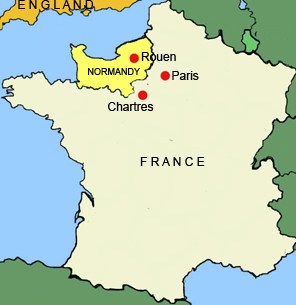
One form of assistance I offer is the addition of three maps which I thought would be helpful or interesting. The map at right is one of these, showing where Normandy is located in France. The region is important because it is the part of present-day France which our Vallée ancestors came from.
You can enlarge some of the images by clicking on the link below them, which will open the image in a new tab or page.
- If the image is still too small, hit Ctrl-+ (the Control key and the Plus key simultaneously) to enlarge it on the new page.
A form of assistance I do not offer is to pass over or offer a summary of some of the exhaustive detail the author engages in. I myself am grateful for every single note from his research which he is willing to provide.
Thank you, Maurice. Vingt-sur-vingt pour votre travail formidable!
Our Ancestors Pierre and Jean Vallée
By Maurice Vallée
Region of Talou, the Birthplace of the Vallée Brothers
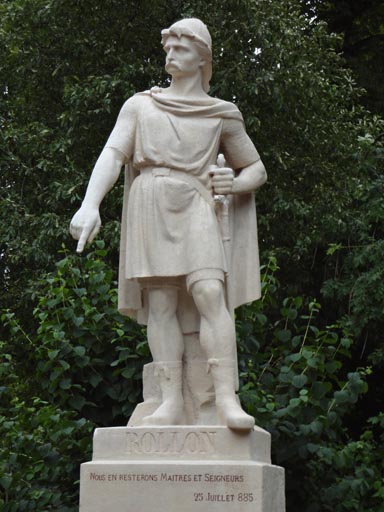
The history of this branch of the great Vallée family has been lost in time, but we do know it began in Talou, a region situated in Northeast France between the Pays de Caux and Picardy. In ancient times this country was inhabited by the Véliocasses, a Gallic tribe who was conquered by the Francs, who were then later conquered by Rollo the Viking and his Danish warriors. It was this ethnic melting pot that, at the start of the 17th century, spawned our Norman ancestors Pierre Vallée and his wife Madeleine DuMesnil. Probably.
Translator's note: The engraving on the statue quotes Rollon as saying, "We will stay here (in Talou), as masters and lords," on July 25, 885.
Birthplace of Pierre and Jean's parents. The genealogists and historians Cambray, Tanguay, Drouin, Jetté, Langlois and Lebel have determined that our Norman ancestor was born in the parish of Saint-Jean of the city of Rouen in Normandy. Only one document supports this claim: the marriage act of his son Pierre Vallée with Thérèse Leblanc, dated January 12, 1665, in Beauport in New France. At the same time the registers of the parish of Saint-Jean, available for consultation at the Municipal Library of Rouen and still in good condition, indicate that the Norman ancestors Pierre Vallée and Magdeleine DuMesnil, did not marry there in Rouen and that neither were their sons Pierre and Jean baptized there. A quick review of the registers of some of the thirty other parishes of the city of Rouen indicate that there just a handful of Vallée families at Rouen in the first half of the 17th century.
Translator's note: The author is constructing an argument that Pierre and his brother Jean were not in fact born in the Parish of Saint-Jean in Rouen. To follow his argument you have to know that back then in France everybody who married did so within the Catholic Church, and everyone who had children had their children baptized in the Catholic Church. Therefore, an absence of church records for a particular person in a particular town means that you are likely looking in the wrong town.
Translator's note: The bulk of the sources for this document comes from marriage contracts and marriage acts. Both were official forms containing detailed information about the persons involved, though it seems that sometimes they contained slightly different information. Marriage contracts were executed some time before the marriage ceremony, which is when the marriage act was signed. (For more on marriage acts, see L’obtention d’un certificat de mariage ou acte de mariage au Québec)
Birthplace of Pierre and Jean. Two other important documents point in another direction: the marriage contracts of Pierre and of Jean Vallée in New France. In the first case, dated November 16, 1664, the notary Vachon indicated the parish of "St Sent," in the Diocese of Rouen, as the birthplace of Pierre. In the marriage contract of Jean Vallée, dated January 7, 1666, the same notary indicated that this person was originally from the parish of "Scainct Sang," in the Archdiocese of Rouen. In addition, Mary Louise Dalton in her article published in 1906, entitled "Notes on the Genealogy of the Vallé Family," mentions the village of Saint-Saëns as the area of origin of the Vallée brothers. The author had consulted with Sir Arthur George Doughty, the celebrated archivist of Canada, and a Mister Gaudet, a genealogist of that time, both of whom had consulted the marriage contracts.
Translator's note: In French, Sent, Sang and Saëns would all be pronounced very similarly; while Scaint would have been a misspelling or poorly handwritten version of "Saint."
Translator's note: Here is the article referenced above: Mary Dalton, "Notes on the Genealogy of the Vallé Family". The link should take you to the starting page of the article, which is part of a scanned copy of multiple volumes from a journal called, I think, The Missouri Historical Society Collections. You "turn" to the next page by clicking on the right arrow at the bottom.
Saint-Saëns and the Vallée Families
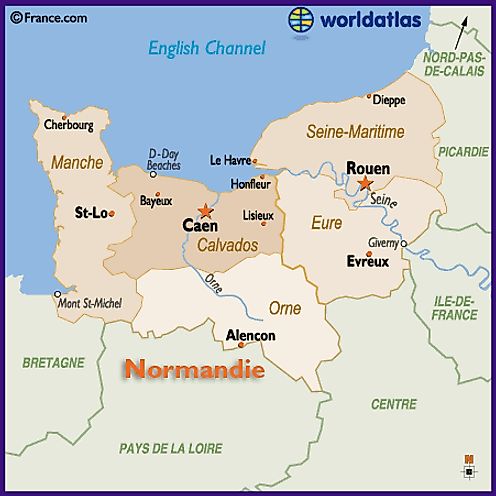
Saint-Saëns is a small town in Normandy situated about 20 miles to the north of the city of Rouen and about the same distance, to the south, of the town of Dieppe. Saint-Saëns lies on the shores of the Varenne River and borders the Eway Forest. Parenthetically we should mention the nearby villages of Louvetot and Muchedent, from which emigrated the Canadian pioneer families Leduc, Lefrançois and Trépanier.
In the 17th century registers, Saëns was written without the final "s" and was pronounced "san", as it is today, which explains the orthographic difficulties of the notary Paul Vachon in New France. The town owes its name to an Irish monk of the name Saën (the name in ancient Gaelic which corresponds to "Jean" in French), who founded a monastery there around the year 675.
According to the registers of the parish of Saint-Saëns, our Norman ancestors Pierre Vallée and Madeleine DuMesnil had a dozen children baptized there.
- Marie, baptized in the church of the village on February 26, 1630 and having Nicolas Vallée and Louise Mesnil as godfather and godmother.
- Jean, baptized March 16, 1631 and having Jean Carrol and Magdelaine Archet as godfather and godmother.
- Jacques, baptized July 30, 1633 and having Jacques Lion and Catherine Mesnil as godfather and godmother.
- Louise, baptized on December 31, 1634 and having Nicolas Dumesnil and Louise Guillebert as godfather and godmother.
- Pierre, baptized on June 6, 1636 and having Guillaume Le Grand and Catherine Carrol as godfather and godmother.
- Marguerite, baptized February 19, 1638 with Éloy Auger and Marguerite Saint-Ours (probable wife of Jacques Dusmesnil) as godfather and godmother.
- Jean, baptized on August 29, 1640 and having Louis Tassin Flanchet and Jacqueline Moulin as godfather and godmother.
- Robert, baptized on March 24, 1642 and having Robert DeLamare and Pierrette Baulon (probable wife of Nicolas Mesnil) as godfather and godmother.
- Adrianne, baptized October 23, 1643 with André Aloyaudes as godfather and Louise Flams as godmother. (Adrianne probably died on October 20, 1669—we're uncertain because the identity of the parents was not indicated by the pastor at the burial.)
- Louis, baptized on July 16, 1645, godchild of Louis Carrol and Anne Simon.
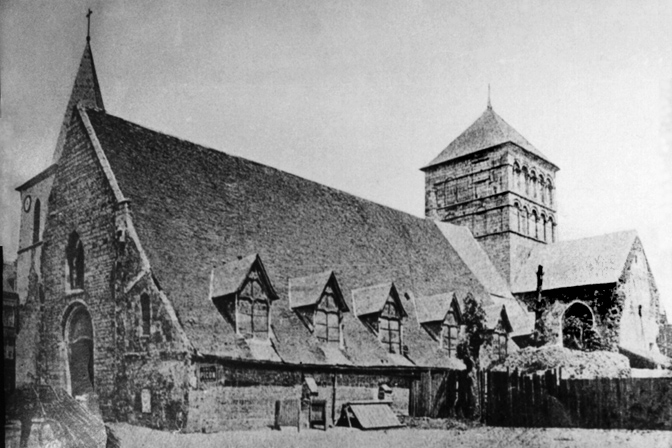
Translator's note: After a little digging I came across a webpage entitled Ville de Saint-Saëns, which reassuringly tells us that the town saved what they could from the original church:
The present Church, the architecture of which was inspired by the Saint Martin de Boscherville Abby has replaced the first edifice destroyed by lightning in 1883. The Church was entirely rebuilt in 1896 and today one can admire the Wonderful stained glass windows (listed, dating from the 14th and 15th centuries.)
There are no other baptisms celebrated by our couple, neither before nor after these dates. It seems therefore that Marie was the first born and Louis, the youngest. In the register, however, a Magdelaine Mesnil was buried in the cemetery of the parish of Saint-Saëns on March 20, 1646. Was this the wife of Pierre, our Norman ancestor? This uncertainty will remain with us due to the fact that the priest did not record the customary details at the time of the burial. Chronologically, this date corresponds to the disappearance in the registers of the couple Pierre Vallée and Magdelaine Dumesnil and to the marriage of a Pierre Vallée with Suzanne Savary on July 31, 1646. Was this our ancestor who remarried? If so, he had at least three more children: Laurens, baptized July 24, 1647; Catherine, April 23, 1649; and Louyse, February 8, 1652. Was the Pierre Vallée who was buried in the cemetery of the village on March 28, 1657 also our ancestor Pierre? Is it mere coincidence that 1657 is the same year in which his son, Pierre, makes his first appearance in the historical record in New France, in a baptismal act of December 28, 1657 in Trois-Rivières?
Translator's note: The author, Maurice Vallée, would have done well to clarify what role Pierre played in this baptism—especially since his marriage would not take place for another eight years. Godfather, perhaps?
More evidence based on research into the public records will be necessary to confirm the connections between these marriages and deaths. Detailed research carried out in June, 1994 into the records at the Departmental Archives of Rouen concerning Dumesnil, Jacques Leblanc and Louis Varengues did not bring back any additional information on the life and family of our Norman ancestor. Was he so poor that he could not afford the services of a notary public? Did he pass his notarial contracts to a recorder in another village? Were there other notaries public in Saint-Saëns whose records have not been preserved? All these questions have no answers.
Translator's note: The original text is not clear what kind of "notarial contracts" (contrats notariés) Pierre is expected to have engaged in. France is reputed to be bureaucratic nation, so perhaps they require much more notarized documentation than we do.
Under the ancien régime [i.e., before the French Revolution], Saint-Saëns was built around a castle or stronghold "in the jurisdiction of which was found many surrounding parishes", according to André Lejeune in his "Notes sur Saint-Saëns" written in 1930 and published in 1999 by the Association for the XIIIth Centennial of Saint-Saëns. Reading the "notarial acts" [actes notariés] of the royal records of the first half of the 17th century has revealed the existence at Saint-Saëns of many Vallées, some of whom are described as surgeons.
The parish registers of the first half of the 17th century of Saint-Saëns, for their part, shed some light on the situation. A dozen baptisms and about fifteen burials consolidate our impression that many Vallée families lived in the village of Saint-Saëns and had been established there for more than a generation. To give ourselves a little more historical context here, let us mention that, according to the "Notes sur Saint-Saëns" of André Lejeune, the plague made its appearance in Saint-Saëns in the year 1628, just two years before the birth of the first daughter of Pierre Vallée and Marguerite Dumesnil. The scourge was then spread throughout the region by "a poor man, a rag-picker by the name of Bault who had acquired some old towels at Saint-Saëns where 'the plague was very widespread.'"
Then came 1639, another year marked by the plague, and, moreover, by the revolt of the Nu-Pieds, which is attributed to the three years of unusually heavy taxation imposed on the French people in order to finance the war on the King of Spain. Finally, on the May 16, 1648, fire was to destroy practically everything in the village of Saint-Saëns. According to Lejeune:
[The conflagration] consumed one hundred and fifty homes of the town, not counting a large number of buildings which were also destroyed. The majority of the victims were reduced to being beggars—the material wealth lost was evaluated at more than two hundred thousand livres. The construction of all these houses, of wood and cob and covered with thatch, provided ready fuel for the flames.
Was it because of these frequent calamities that Pierre and Jean Vallée left their village? These, on top of the numerous taxes, would certainly have disheartened many young people. With their mother and father probably deceased, they had no family ties to keep them there. Add to all that the lure of adventure and the promises of the merchants of Rouen charged with bringing immigrants into New France (promises incentivized by the merchants' exclusive rights to the exportation of beaver pelts), nothing more would be necessary to persuade the two young Vallée brothers to board ship.
Crossing the Atlantic
Our research hypothesis is that the Brothers Vallée embarked at Dieppe for New France during the summer of 1657 on one of ships commanded by Captain Poullet and financed by the merchants of Rouen, the Saint-Sebastien, and they did this in the company of Charles LeFrançois from Muchedent, a village situated a few miles from Saint-Saëns.
Translator's note: Charles LeFrançois from Muchedent turns up later in this story as the godfather of Jean's son, Charles. For the meager results of some online research prompted by this paragraph see The Crossing to America.
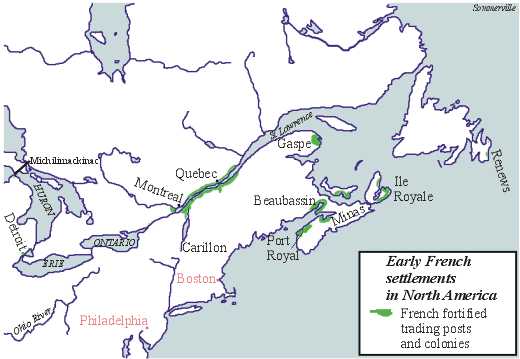
Translator's note: In addition to Montreal, Quebec and Gaspé, place names mentioned in Maurice Vallée's article are:
- Beauport: Just downriver from (i.e. northeast of) Quebec City, on the same northwest side of the river
- Château-Richer: a town just downriver from Beauport
- Trois-Rivières: city midway between Quebec City and Montreal, on the same northwest side
- Lachine: borough within the city of Montreal, located on the south side of Montreal, on the north side of the river.
- Laprairie: suburb of Montreal, on the other side of the river
- Rivière-Ouelle: town on the eastern side of the St. Lawrence, about 80 miles downriver from Quebec City
- Beauce: an agricultural region about 70 miles south of Quebec City
- l'Île-d'Orléans: an island in the St. Lawrence River close to Quebec City
Some employer in the New France probably hired them for a period of three years following the signature of a notarial contact (which would be interesting to find). The employer must have paid for their passage and advanced a certain part of their salary, which would have been roughly 75 livres per year.
Pierre Vallée in America
It was on the 16th of November 1664, in the presence of the notary Paul Vachon, that Pierre Vallée dit Lavallée concluded a marriage contract with Thérèse Leblanc, his future wife. Also in attendance were:
Translator's note: "Pierre Vallée dit Lavallée" In this context dit should be thought of as meaning "called," and it indicates a kind of nickname that eventually became formal. See dit names.
- Léonard Leblanc and Marie Riton, his future father- and mother-in-law
- Jean Vallée, Pierre's brother
- Robert Giffard, the seigneur of Beauport, and Marie Renouard, his wife
Translator's note: "the seigneur of Beauport" The word seigneur could be translated as "lord" or similar, but doing so would fail to capture Robert Giffard's role in the seigneurial system: essentially, a seigneur was a Very Important Person in the colony who was appointed landlord of a large tract of land by the King or his inner circle. For more information see the "Seigneuries" section here
- Marie Giffard, wife of Jean Juchereau (not present)
- René Chevalier and Jeanne Langlois, his wife
- Nicolas Juchereau of Saint Denis
- Noël Langlois, Paul and Jean DeRainville, and Pierre Marcou

Translator's note: (1) In full, the image caption reads, "Signature of Pierre Vallée dit Lavallée, Master Surgeon, taken from the marriage contract of his brother Jean." (2) It's not clear why the author has taken the signature from Jean's marriage contract rather than Pierre's own. (3) The first part of the signature clearly reads "p lavallée." It's very difficult to read the second half as "maître chirurgien" (French for master surgeon).
Pierre celebrated his marriage with Thérèse Leblanc at Beauport on January 12, 1665. The marriage act is recorded in the parish register of Notre-Dame de Quebec.
Pierre Vallée and Thérèse Leblanc had ten children during their 21 years of life together. Here are a few notes on each of them.
-
Thérèse Vallée was born around 1667 and died at Beauport on October 29, 1722 at the age of 55. Her burial took place the next day. Thérèse doesn't appear to have been married and left behind little information about her life.
-
Marie Vallée was born around 1668. Her marriage contract was signed at the office of Notary Paul Vachon on February 9, 1687. Marie married Jean-François Parent, son of Pierre Parent and of Jeanne Badeau, at Beauport on the next day, in the presence of Joseph Rancourt, Paul Vachon and Jean Badeau. She died and was buried at Beauport on December 11, 1720. Marie Vallée had eleven children from this marriage.
-
Suzanne Vallée was born on the 12th and was baptized, according to the register of the parish of Notre-Dame de Quebec, on the 16th of March, 1670 in the Chapel of Beauport by a Jesuit missionary. She had as godfather and godmother Noël Langlois and Suzanne Benet, wife of Jean Gibault, and she married René Beaudin, son of Charles Beaudin and Jeanne Moinet, in Beauport on February 10, 1687. Suzanne married on the same day as her sister Marie, in the presence of René Rémy, Paul Vachon, Noël Langlois and Léonard Leblanc. The marriage contract had been signed at the office of Notary Paul Vachon on January 5 of the same year. After a life of toil in Quebec, then in Gaspee and finally at Laprairie, Suzanne died in Laprairie on December 8, 1729 and was buried on the 9th. Suzanne Vallée and René Beaudin had six children together.
Translator's note: "After a life of toil (Après une vie de labeur)" It is not clear what kind of toil or labor in particular the author means. It would be interesting to find out in what way the difficulty of her life was more noteworthy than, for example, that of her siblings.
-
Marguerite Vallée, born on February 17, 1672, was baptized, according to the register of the parish of Notre-Dame de Quebec, in the chapel of Beauport on the 21st of the same month. Serving as her grandparents were Noël LeBlanc and of Marguerite Langlois, wife of Paul Vachon. She married Jean-Baptiste DeRainville, son of Jean DeRainville and Suzanne Badeau, on January 30, 1690 in Beauport in the presence of Léonard LeBlanc, her grandfather, Pierre Marcou, Toussaint Giroux and René Beaudin. The marriage contract was carried out on the 20th of the same month at the office of Notary Gilles Rageot. At the age of 77 Marguerite Vallée died in Beauport on October 31, 1759, and was buried on the first of November. Marguerite had six children from her marriage.
-
Pierre-Vincent Vallée was born on September 29, 1674 and was baptized the 3rd of October in Beauport. He was the godchild of Vincent Brunet and Élisabeth de la Guéripière. His first marriage was with Marie-Madeleine Vachon, the daughter of Paul Vachon, royal notary, and of Marguerite Langlois on November 23, 1699 in Beauport. The marriage contract was signed before the notary Jean-Robert Duprac on October 24 of the same year in the presence of his father and mother and of his brothers Michel and Nicolas. It's worth noting that on the marriage contract Pierre-Vincent declared "master carpenter" as his occupation. Two children were born of this union between Pierre and Marie Madeleine, who died of smallpox, it seems, on February 17, 1703 and who was buried in Beauport on the 18th, two days before the death of her own daughter of the same first name. Pierre-Vincent then remarried on July 21, 1704 in Beauport, this time to Marie-Madeleine Courault De Lacoste, originally from Lachine, daughter of Cybard Courault, squire, and of Françoise Goupil. According to the marriage contract signed before the notary Jean-Robert Duprac on the preceding 13th of July, Marie-Madeleine was the adoptive daughter of Mathieu Lagrande and Marie-Gabrielle Danneville, and the widow of René Parent. Present at the marriage were: Mathieu LaGrange, Jean Parent, Jean DeRainville and Michel Vallé, brother of the groom. From this second marriage nine children were born. Pierre-Vincent indicated he was Captain of the Militia on the marriage contract of a son from this second marriage, Ange-Étienne, in 1735. In the census of the autumn of 1744, he was living on Rue Saint-Jean in Quebec. He died on the 10th of November, 1751, and was buried the next day in Quebec.
-
Michel Vallée, second son of Pierre, was born around 1676 (he is recorded as being 5 in the 1681 census). He married Geneviève Baugis, daughter of Jean Baugis and of Thérèse Parent, in Beauport on the February 3, 1712. Present at the marriage were Jean Baugis, father of the bride, Charles Vallée, Jacques Avisse and Jean Miville, architect of Québec. The marriage contract was signed on the preceding day in the presence of Notary Jean-Robert Duprac. Michel died on September 30, 1752 and was buried on October 1st in Beauport after having more than a dozen children, of whom three died tragically.
-
Louis-Charles Vallée, the third son of Pierre, was born around 1678 (the 1681 Census having him as 3 years old). He married Geneviève Marcou, daughter of Pierre Marcou and of Marthe DeRainville, in Beauport on September 12, 1707. Present at the marriage were Noël Maillou, Jean DeRainville, André Marcou and Jean Gagnier. The marriage contract was signed in the presence of the Notary Jean-Robert Duprac on the preceding day. Louis-Charles died in Beauport on February 21, 1753 and was buried the next day in the parish cemetery. From his union with Geneviève Marcou, Louis-Charles Vallée had eleven children in Beauport.
Translator's note: Louis-Charles is Charles La Vallée, father of François Vallée I, the subject of Ekberg's biography and my ancestor.
-
Nicolas-Marie Vallée, fourth son of Pierre, was born and baptized on April 27, 1681 in Beauport; his godfather and godmother were Nicolas Juchereau of Saint Denis and Marie-Madeleine Marsolet, wife of François Guyon. He first married Marie-Louise Lefebvre, daughter of Jean Lefebvre dit Chartrand and Marie Creste, in Beauport on November 22, 1712. Present at this marriage were Jean Lefebvre, father of the bride, Pierre Jourdain, Charles and Jean-Marie Delinot and many other friends. Marie-Louise Lefebvre died on December 10, 1730, six days after having given birth to her last son, André. Many years later, on July 23, 1736 in Quebec, Nicolas Vallée was married for the second time to Marie-Anne Benoit dit Abel, widow of Jean Sylvestre and daughter of Pierre Benoit and Marie Dionne, in the presence of his brother Pierre Vallée, Jean Spénard, Ignace Constantineau and Pierre Grandjean. The marriage contract had been signed at the office of the notary Barbel on the preceding day. Nicolas Vallée died on August 1st, 1766 in Beauport and was buried on the second. He and Marie-Louise Lefebvre had 12 children altogether.
-
Marthe Vallée was born and baptized on the 24th and 25th of April, 1683 in Beauport. She was the godchild of Pierre Morel and of Marthe DeRainville, wife of Pierre Marcou. She married Charles Miville dit Deschênes, son of Jaques Miville and of Catherine DeBaillon, in the church of Notre-Dame-de-Liesse de Rivière-Ouelle on August 28, 1702. She died in the parish of Sainte-Anne-de-la-Pocatière on March 21, 1748. Marthe Vallée gave birth to eleven or twelve children.
-
Charlotte Vallée, the last daughter of Pierre, was born on the 20th and baptized the following day, the 21st of September, 1685 in Beauport. She had as godfather Jean Provost and as godmother Marie Lefebvre. She married Pierre Chauveau, son of Pierre et de Péronne .... Chauveau, in Beauport on August 22, 1707. Pierre Chauveau was a cooper, navigator and captain of the militia. Present at the marriage were Pierre, Nicolas and Michel Vallée, brothers of the bride, and Jean Parent, her brother-in-law. The marriage contract had just been signed in the presence of Notary LaCetière on the preceding day, the 21st of August. Charlotte Vallée died in Quebec on September 18, 1756 was buried on the 19th. She gave birth to a dozen children.
Pierre Vallée dit Lavallée and Thérèse Leblanc had more than 90 grandchildren (94, to be exact). This branch of the Vallées centered near Beauport, but also grew in the Gaspé Peninsula and Beauce—not to mention the present-day United States, where the most famous of this lineage were François Vallée dit Lavallée, commander of Fort Sainte-Geneviève in Illinois in the 18th century, as well as Rudy Vallée, singer and bandleader during the first half of the 20th century. In Quebec, one must also mention the photographer Louis-Prudent Vallée, well-known for his stereoscopic scenes of the City.
Jean Vallée in America
On March 22, 1664, our ancestor Jean Vallée obtained by contract, in the presence of the notary and mason Paul Vachon, a land grant from Monsieur Charles de Lauzon of l'Île-d'Orléans. It consisted of a little over two acres located between the properties of Jean Guy and of Joachim Martin in the Lirec fiefdom, which had been separated from the Seignory of l'Île-d'Orléans in 1656. The proximity of Joachim Martin and in particular that of Marie, his sister, who had arrived not too long beforehand, would shape the destiny of our ancestor and, by extension, of ourselves.
According to the couple's contract and act of marriage, Jean Vallée's bride, Marie Martin, was originally from the parish of Notre-Dame-de-Cougnes, in the town of La Rochelle, in Aunis [France]. In fact, she was baptized on January 9, 1649 in the church of Sainte-Marguerite de La Rochelle, according to the book Un Martin en Amérique: Joachim Martin, born in Aytré, 1636-1690 by Marcel Martin (published by Septentrion in 1997).
The marriage contract of Jean Vallée, 26 years old, and of Marie, 16 years old, was executed in the presence of the seigneurial notary Paul Vachon on January 7, 1666 and the marriage itself was celebrated roughly a month later, on Thursday the 4th of February, 1666. They married in the parish of La Visitation-de-Notre-Dame in Château-Richer, according to the transcription done in 1926 by Amédée Gosselin, priest and archivist of the Seminary of Quebec, in charge of caring for the original documents, which are in very bad condition.

From the marriage of Jean Vallée and Marie Martin three children were born in l'Île-d'Orléans: Marie-Madeleine, Charles and Élisabeth.
-
Marie-Madeleine Vallée was born on Saturday, the 21st of July, 1668, and was baptized on the 23rd in the parish of Sainte-Famille of l'Île-d'Orléans. Her godmother was Anne Martin, wife of Jacques Raté. As for the godfather, his name on the document is illegible. On December 13, 1684 in Quebec, Marie-Madeleine signed in the presence of Notary Genaple of Bellefonds her marriage contract with Phillipe Létourneau, widower of Marie-Madeleine Simon, and son of David Létourneau and of Jeanne Baril. At the time Marie-Madeleine Vallée was 16 years old and living with her mother near the Hôtel-Dieu in Quebec. The young couple married on Monday, February 12, 1685 in the parish of Notre-Dame of Quebec, in the presence of Pierre Vallée (paternal uncle of Marie-Madeleine), Henri DeLaunay (wheelwright) Robert Pépin (slater), Louis Marcier and Louis Mignault. Marie-Madleine and Philippe had two children.
-
Charles Vallée was born on Friday, the 7th of February, 1670 and was baptized on the 13th—like Marie-Madeleine, in the parish of Sainte-Famille. His godfather was Charles LeFrançois and his godmother, Anne Petit, second wife of Joachim Martin, his uncle. This Charles LeFrançois was originally from Muchedent, a region situated not far from Saint-Saëns, homeland of Jean Vallée. A few days short of his 24th birthday, Charles Vallée married Marie-Ursule Gendras, daughter of Piere-Jean Gendras and Marie Charpentier, in Sainte-Anne-de-la-Pérade. The marriage contract was signed in the presence of Royal Notary François Trottain dit Sant-Seürin of Bastiscan on January 24, 1694. Edmond de Suève, seigneur, was present. About a week leter, Nicolas Deleuse, a priest originally from Toul, in France, blessed their marriage on Wednesday, the 3rd of February, 1694 in the chapel of Saint-Nicolas near the seigneur's manor in Sainte-Anne-de-la-Pérade. According to the burial record dated October 25, 1742, Charles Vallée died suddenly the preceding day, the 24th, without having received the last rites, and he was buried in the cemetery of Sainte-Anne-de-la-Pérade in the presence of a large part of the residents of the parish. Charles had just turned 72. He left behind thirteen children and a long list of grandchildren. In this way, Charles became head of one of the major Vallée branches in New France.
-
Élisabeth Vallée was born on Sunday, the 27th of March, 1672 and was baptized on the 4th of April, in the parish of Sainte-Famille de l'Île-d'Orléans (like her two siblings). Her godfather was Jean Gaudreau and her godmother Élisabeth Gaudreau. On Thursday, the 22nd of May, 1692, in the parish of Notre-Dame in Quebec, Élisabeth married the troop sergeant Jean-Joseph Belon, son of Jean-Joseph, seigneur of Portail and of Catherine LeGuié from Saint-Solenne in Blois, in the Diocese of Chartres [France]. Jean-Joseph was part of the Valleraine Company. Élisabeth and Jean-Joseph were married in the presence of Jean-Étienne Dubreuil, Jean Gauthier, Jean Thyerri, Pierre Latintenne and of Lady Anne Gasnier dit Bourdon. Élisabeth and Jean-Joseph Belon had two children.
Translator's note: "Valleraine Company (la companie de Valleraine)" I think this must be the company in which he served as troop sergeant, but no web searches on this name produced any useful result.
Our ancestor Jean Vallée died in 1673 between January 28 and June 22, and was buried in l'Île-d'Orléans. The inventory of the deceased's worldly goods—which, in principle, must be done during the three months following the death—helps us date more precisely this sad event. The inventory was made by Notary Paul Vachon in the presence of Joachim Martin, on June 22, 1673.
Jean Vallée, having a more reserved disposition than his brother Pierre, left very few traces in New France. His descendants settled principally in Sainte-Anne-de-la-Pérade but equally in Baie-du-Febve, then in the Eastern Cantons and in Massachusetts. The most renowned of this Vallée line were certainly the patriots Joseph Vallée husband of Thérèse Rodney, and his son Guillaume-Jacques-Léon Vallée, husband of Henriette Courcelles dit Chevalier, who was found guilty of high treason in 1838 in Montreal.
Translator's note: "the patriots Joseph Vallée ... and his son Guillaume-Jacques-Léon Vallée ... who was found guilty of high treason in 1838 in Montreal" This is most certainly a reference to the Canadian Patriote movement. To quote from the Wikipedia entry:
The movement was at once a liberal and republican reaction against colonial control of the government of Lower Canada, and a more general nationalistic reaction against British presence and domination over what had previously been an exclusively French settler colony.
I have not been able to find any mention of these Vallée patriots online, not even Guillaume's conviction for high treason.
A Commemorative Plaque in Saint-Saëns
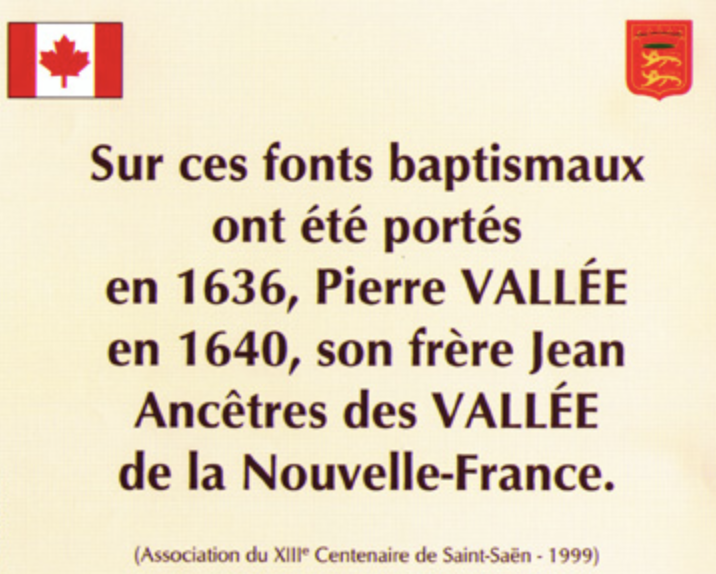
Some time ago, the town of Saint-Saëns created an advisory committee which eventually proposed an overall plan to draw attention to the historic sites located there. As a result, a plaque commemorating the baptisms of our Vallée ancestors was commissioned. The plaque was fixed to the interior wall of the church, near the baptismal fountains by the Association for the 13th Centennial of Saint-Saëns.
The unveiling of this commemorative plaque took place on Saturday, the 29th of July, 2000 at 11:30 in the morning to the sound of the church bells. Present at the occasion were:
- the Deputy-Mayor of Saint-Saëns, Monsieur Alain Le Vern, who was also the President of the Regional Council of Haute-Normandie
- the curé [pastor] of the Parish of Saint-Saëns
- Monsieur Claude Fournier, president of the Association for the 13th Centennial of Saint-Saëns, as well as his wife
- various friends, relatives and notables of Saint-Saëns, of the family of Léo Vallée de Vancouver (on Canada's Pacific coast), and of myself, from Montreal
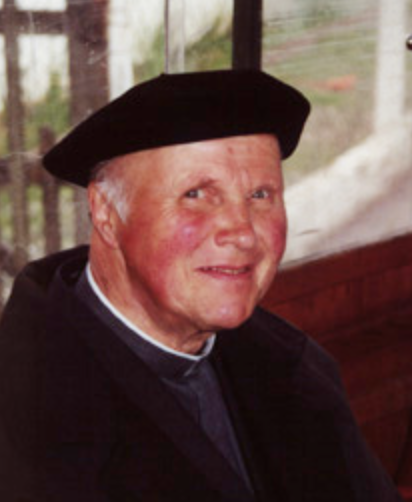
We should also point out the presence of Mayor Marcel Horcholle of the Village of Muchedent, as well as the artist-painter Bernard Pruvost, born in Longueuil (across the river from Montreal), and therefore slightly Canadian, though longtime resident of Critot in Normandy and recently relocated to Saint-Saëns.
Translator's note: The plaque reads: "In these baptismal fonts were placed, in 1636 Pierre VALLÉE, in 1640 his brother Jean, ancestors of the VALLÉE family of New France."
Translator's note: "the artist-painter Bernard Pruvost, born in Longueuil (across the river from Montreal), and therefore slightly Canadian, though longtime resident of Critot in Normandy and recently relocated to Saint-Saëns (l'artiste-peintre Bernard Pruvost de la localité de Critot et d'un petit canadien né à Longueuil (en face de Montréal) et résidant de Saint-Saëns depuis peu)." I struggled with the phrase et d'un petit canadien—the wording is opaque to me and I suspect an inside joke.
Translator's note: The original text has links to some photos not reproduced here.
Further Reading
You will find copies of my notes on our Vallée ancestors in the following locations:
- Société généalogique canadienne-française (coin Davidson et Sherbrooke, Montréal)
- Société de généalogie de la Mauricie et des Bois-Francs (Trois-Rivières)
- Société de généalogie de Québec (Ste-Foy)
- Bibliothèque et Archives nationales du Québec (BAnQ) à Montréal (535, avenue Viger est)
- Syndicat d'initiative de la ville de Saint-Saëns
Translation Ends Here
